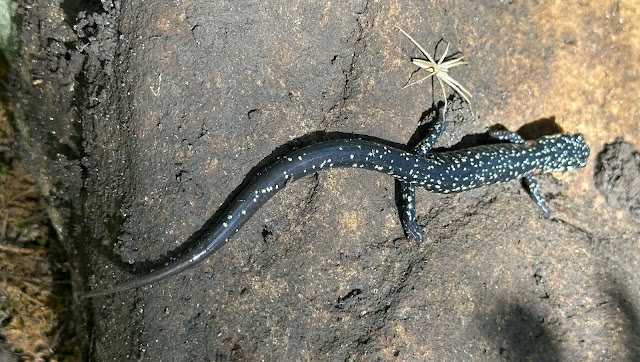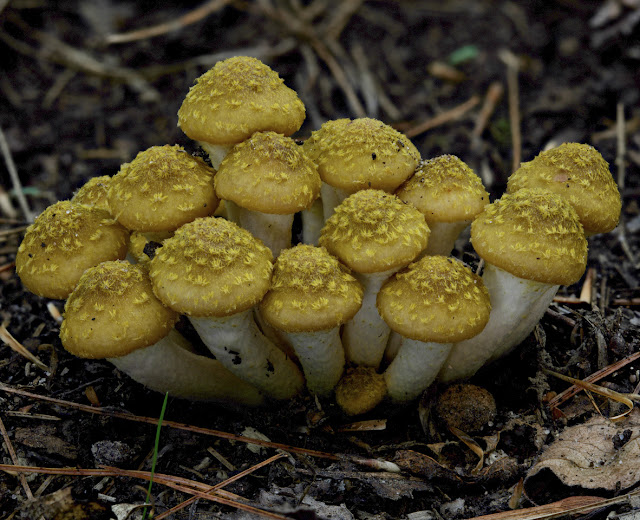 |
| Pilobolus crystallinus |
A special guest blog from our favorite mycologist, Dr. Mark Bower. But first read his poem, a paen in the Poop to a fungus among-us.
=====================
Fun with Da Dung Fungus
Searching for mushrooms is such a strain
As I sat for a while
To relieve the pain
I spot a brown pile
Lumpy it was and also quite stinky
Into the mass I stuck my pinky
As it happens, I shouldn’t have done that
For I quickly found out it was a pile of scat
Mycelia feeding
But it’s had its fill
Time to throw hats
With the spores, if you will
Pow, pow, pow!
The sporangia explode!
Up to ten feet
The hats will be throw'd
Out towards the sun
Soaring like a bird
Hoping to land
On another deer turd
========
Back to Mark's story:
I am always on the lookout for fuzzy poop, and was lucky to come upon this example at Bull Creek in September. I didn’t have my good camera with me, so the photos are of poor quality. Nevertheless, here is the story:
Pilobolus crystallinus, the hat-throwing fungus or dung cannon (seen in action here) is a decomposer of the dung of various mammals, in this particular case, whitetail deer. Its mycelium feeds on fresh dung. When the nutrients are depleted, or if conditions otherwise dictate, the fungus forms its spore-containing fruiting bodies (sporangia).
These sporangia consist of a fluid-filled globular structure sitting on a stalk. At the apex of the sporangium sits a black “hat” which encases the spores.
.jpeg) |
Sporangium- click to enlarge
|
Somehow, the fungal spores must find fresh dung in which to germinate. It has devised an ingenious method of doing so. The sporangium builds up hydrostatic pressure until it finally explodes, and “throws” the black "hat" spore case as far as ten feet. After landing on a blade of grass or a fresh leaf, it may possibly be devoured by a passing deer. If so, the spores will pass through the digestive tract of the deer, then be deposited in a fresh pile of scat. Spore germination occurs, and the cycle is complete.
But why does the hat-thrower go to such lengths to eject its spores? The reason for this is the following: deer, cattle and most mammals don’t like to browse near poop. By ejecting the spores far away, the probability of ingestion is increased. For the same reason, the fungal sporangia are phototropic, that is, the stalks orient themselves towards the sun. They only shoot their spores in the morning and evening when the sun is at an angle, which maximizes the distance they can achieve.
As if that isn’t weird enough:
Lungworms are parasites of various animals, and are commonly found in the lungs of deer. The adults can be as long as 3 inches. When the lungworms are ready to reproduce, they lay eggs in the lungs. When they hatch, the larvae infect the trachea and bronchi of the deer, causing a form of bronchitis. The deer cough up gobs of larva-containing phlegm and inevitably swallow some of it. The larvae are deposited in fresh dung where they feed and thrive. If the larvae are fortunate, the sporangia of Pilobolus will also be present in the dung. The larvae crawl up the stalk of the sporangium and curl up on the black spore case, awaiting lift off. As the spore case is ejected, the larvae get a free ride away from the dung pile. They are then ingested by a deer and enter the blood stream and lymphatics through the wall of the intestines. They then travel through the blood to be deposited in the lungs, to mature into the adult worms. These lungworms rely on Pilobolus to complete their life cycle. The fungus does not benefit and is not harmed by the association.
If you are ready for some more fungal-culture I would highly recommend this poem by Tom Volk.
 This tree above was on its last legs but still managing to produce a few leafy branches high up to catch what little light came through from its healthy neighbors. It gave up the ghost a few years later.
This tree above was on its last legs but still managing to produce a few leafy branches high up to catch what little light came through from its healthy neighbors. It gave up the ghost a few years later.







.jpeg)

.jpeg)






.jpeg)


.jpeg)














.jpeg)


.jpeg)

